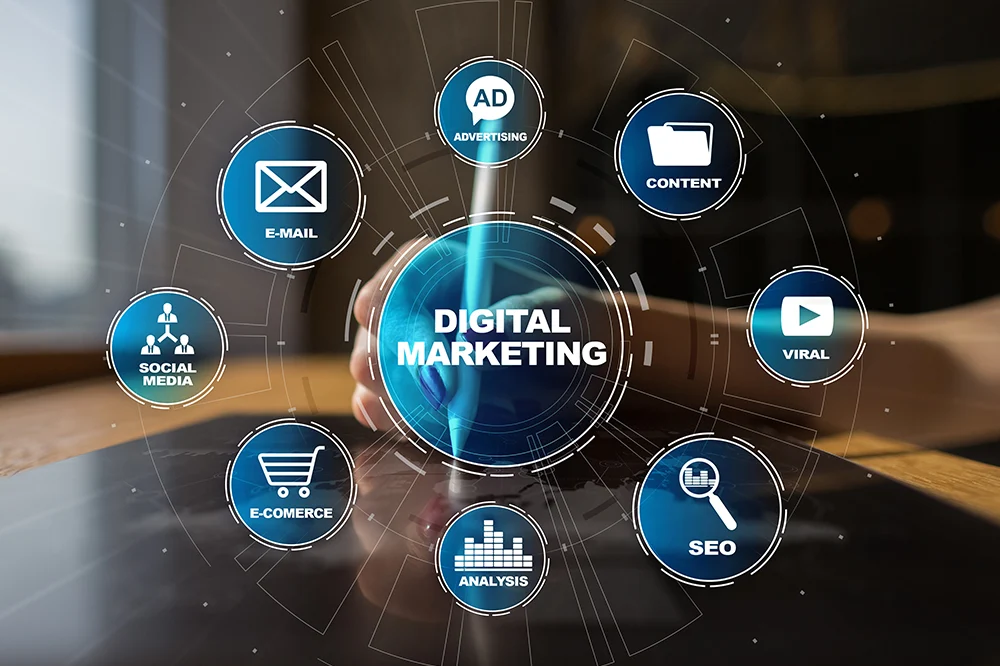In recent years, digital marketing has rapidly evolved, transforming how businesses connect with customers and engage with their audiences. The digital landscape is continually changing due to advancements in technology, shifts in consumer behavior, and the increasing use of social media and mobile devices. As the way people consume information and interact with brands continues to change, so too must the strategies that businesses use to engage with their target market.
The future of digital marketing holds vast opportunities for growth and innovation. This article explores the major trends shaping the future of brand engagement and how marketers can leverage these changes to create successful campaigns that resonate with their audiences.
1. The Rise of Artificial Intelligence (AI) and Machine Learning
Artificial Intelligence (AI) and Machine Learning (ML) are no longer futuristic concepts; they are already transforming digital marketing. From personalized marketing messages to chatbots and data analytics, AI is helping businesses optimize their campaigns and improve the customer experience.
Personalization at Scale: AI-powered tools allow marketers to deliver highly personalized experiences to individual customers, based on their browsing history, preferences, and behavior. Machine learning algorithms can analyze vast amounts of data in real-time to identify patterns and predict future behaviors, enabling marketers to create more targeted campaigns.
Chatbots and Automation: Chatbots powered by AI are increasingly common on websites and social media platforms. These bots help businesses interact with customers 24/7, answering questions, providing recommendations, and guiding users through the sales funnel. Automation is also being used to streamline marketing processes such as email campaigns, social media posting, and ad targeting.
Impact on Brand Engagement:
- Personalized content delivery that resonates with individual customers.
- Real-time, responsive customer service through AI-driven chatbots.
- Automated processes that reduce manual effort and optimize marketing workflows.
2. The Growth of Video Marketing
Video has become one of the most powerful tools for brand engagement in the digital age. Platforms like YouTube, Instagram, and TikTok have proven that short-form and long-form video content can capture the attention of audiences and drive significant brand awareness.
Live Streaming and Interactive Content: Live streaming allows brands to engage with customers in real time, creating an authentic and personal connection. Whether it’s behind-the-scenes looks, Q&A sessions, product launches, or webinars, live video fosters a sense of urgency and exclusivity that other formats can’t match. Interactive video, such as polls, clickable links, and choose-your-own-adventure style videos, also boosts engagement.
Short-Form Video Content: TikTok and Instagram Reels have popularized short-form videos, and brands are increasingly using these platforms to connect with younger audiences. These bite-sized videos offer an opportunity for businesses to deliver quick, memorable content that resonates with users.
Impact on Brand Engagement:
- Increased emotional connection with brands through authentic, live content.
- Greater reach through viral, short-form video content.
- Enhanced interactivity that encourages user participation and engagement.
3. Influencer Marketing and User-Generated Content
Influencer marketing has exploded over the last decade, and it continues to grow as brands turn to social media personalities to promote their products and services. What started with a few high-profile celebrities has expanded to include micro and nano-influencers, people with smaller but highly engaged audiences.
Micro-Influencers and Niche Audiences: Micro-influencers (those with fewer than 100,000 followers) tend to have highly engaged audiences, which makes them more valuable for targeted campaigns. These influencers often have a stronger personal connection with their followers, which leads to more authentic recommendations.
User-Generated Content (UGC): UGC is content created by consumers rather than brands. This type of content can range from product reviews and social media posts to unboxing videos and testimonials. UGC has become an essential part of digital marketing because it provides social proof and helps build trust with potential customers.
Impact on Brand Engagement:
- Authentic brand endorsements through influencer partnerships.
- Increased consumer trust through UGC, which acts as word-of-mouth marketing.
- More targeted and niche marketing by collaborating with influencers in specific industries or interests.
4. Voice Search and Smart Devices
With the rise of voice assistants like Amazon Alexa, Google Assistant, and Apple Siri, voice search is becoming a critical element of digital marketing. As people increasingly use voice commands to search for products, services, and information, brands need to optimize their content to be discoverable through voice search.
Optimizing for Voice Search: Voice search queries tend to be more conversational and long-tail (e.g., “What are the best coffee shops near me?” vs. “best coffee shops”). Marketers will need to optimize their SEO strategies to account for these differences and ensure their brand shows up in voice search results.
Smart Devices and Marketing Integration: As smart devices like smart speakers, connected refrigerators, and wearable tech continue to evolve, they provide new opportunities for marketers to engage with consumers in innovative ways. These devices can be integrated into marketing campaigns, offering new channels for brand communication.
Impact on Brand Engagement:
- Improved discoverability through voice-optimized content.
- Direct engagement through smart devices, such as personalized offers or promotions.
- Increased interaction with consumers via voice search, leading to higher conversion rates.
5. The Importance of Privacy and Data Security
In recent years, concerns over data privacy have escalated, particularly with the implementation of stricter regulations like the General Data Protection Regulation (GDPR) in Europe and the California Consumer Privacy Act (CCPA) in the U.S. As privacy concerns rise, consumers are becoming more selective about the data they share with brands.
Building Trust through Transparency: Brands that prioritize privacy and data security can build trust with their customers. By being transparent about how data is collected, used, and stored, businesses can differentiate themselves in a competitive marketplace. Offering customers control over their personal information and how it’s used can also increase loyalty.
Impact of Privacy on Digital Marketing:
- Increased emphasis on data protection and ethical use of customer data.
- Stronger consumer trust and loyalty when brands are transparent about privacy practices.
- More emphasis on creating value-driven marketing strategies that respect consumer privacy.
6. Augmented Reality (AR) and Virtual Reality (VR)
Augmented Reality (AR) and Virtual Reality (VR) are becoming increasingly integrated into digital marketing strategies, providing innovative ways for brands to engage with consumers. AR allows brands to overlay digital information onto the physical world, while VR creates immersive digital experiences.
AR for Product Trials: Brands in industries such as fashion, beauty, and home decor have adopted AR to let customers try products virtually before making a purchase. For instance, AR can allow users to “try on” clothes, visualize furniture in their homes, or test out makeup looks.
Immersive Brand Experiences with VR: VR enables brands to create completely immersive experiences for their audience. These can include virtual store tours, interactive brand stories, or product demos that transport users to another world.
Impact on Brand Engagement:
- Increased engagement through interactive and immersive experiences.
- A more personalized shopping experience with AR product trials.
- Enhanced brand loyalty through innovative and memorable brand interactions.
7. Social Commerce and Shoppable Posts
Social commerce, which involves selling directly through social media platforms, has seen explosive growth. Platforms like Instagram, Facebook, and Pinterest now allow users to shop directly from their feeds, creating a seamless shopping experience.
Shoppable Content: By integrating e-commerce functionality into social media platforms, brands can allow consumers to purchase products without leaving the app. This reduces friction and makes the shopping experience more convenient, leading to higher conversion rates.
Influence of Social Proof: Social proof, such as reviews, testimonials, and product recommendations from friends or influencers, will continue to drive social commerce. By allowing users to share their purchases and experiences, brands can harness the power of peer recommendations to boost sales.
Impact on Brand Engagement:
- Direct sales through social media platforms without needing to leave the app.
- Increased impulse buying due to frictionless shopping experiences.
- Stronger customer relationships through the use of social proof and peer recommendations.
Conclusion
The future of digital marketing is exciting and full of opportunities for brands to engage with their audiences in innovative ways. As technology continues to evolve, digital marketers must stay ahead of trends and embrace new tools and platforms to remain competitive. AI, video marketing, influencer partnerships, voice search, privacy considerations, AR/VR, and social commerce will all play significant roles in shaping how brands interact with consumers.
By adopting these trends, businesses can create more personalized, engaging, and relevant experiences for their customers. As the digital landscape evolves, brands that are willing to innovate and experiment with new strategies will be best positioned to succeed in the rapidly changing world of digital marketing.
Key Takeaways:
- AI and Machine Learning: Revolutionizing personalization and automation in digital marketing.
- Video Marketing: Increasing importance of live streaming, short-form content, and interactive video.
- Influencer Marketing & UGC: Continuing to drive authentic engagement and brand trust.
- Voice Search & Smart Devices: Changing SEO strategies and creating new touchpoints for brand engagement.
- Privacy and Data Security: Becoming more crucial as consumers demand transparency and control.
- AR/VR: Offering immersive, innovative brand experiences.
- Social Commerce: Shaping the future of e-commerce through social media platforms.
To remain competitive, brands must embrace these trends and adapt to the ever-changing digital landscape.

